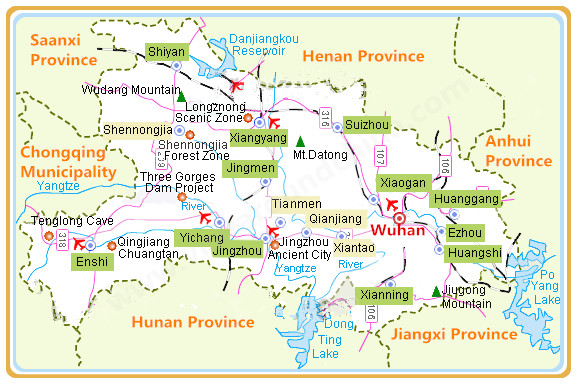Skype: neodalle-travel
Tel: +86 135 7447 2266
E-mail: sales@zhangjiajieholiday.com

 Hubei Province,located in the middle reaches of the Yangtze River and to the north of Dongting Lake in south cantral of China, is surrounded by Henan Province to the north, Jiangxi and Hunan Province to the south, Anhui Province to the east, Sichuan and Chongqing to the west, Shaanxi Province to the northwest. Hubei has been said to be one of the originating places of the Chinese people. Its capital, Wuhan, is located in the southeastern part of the province.
Hubei Province,located in the middle reaches of the Yangtze River and to the north of Dongting Lake in south cantral of China, is surrounded by Henan Province to the north, Jiangxi and Hunan Province to the south, Anhui Province to the east, Sichuan and Chongqing to the west, Shaanxi Province to the northwest. Hubei has been said to be one of the originating places of the Chinese people. Its capital, Wuhan, is located in the southeastern part of the province.
Facts of Hubei
Chinese Name: 湖北 (hú bêi)
Abbreviation: 鄂 (è)
Administration Type: Province
Capital: Wuhan City
Location: northern Dongting lake in south central China
Area: 69,500 km²
Population (2015): 61.28 million
Nationalities: Han,Tujia,Miao,Dong,Hui
Hubei History & Culture
Hubei, known as Chu in ancient times, was the seat of power of the Zhou Dynasty. During 475 to 221 BC, Chu was involved in many battles with the neighboring state of Qin, now Shaanxi Province.
Chu gradually lost most of its territories to the Qin. The Qin were then deafeated by the Han, who established their capital in erstwhile Jingzhou, now the area occupied by Hubei and Hunan. Through the years, Hubei was occupied by successive dynasties.
Hubei was renamed the Province to Jinghubei in 982, Song Dynasty(907-1227). In 1339, the Mongols overran Hubei and united it with Hunan, Guangdong and Guangxi and called it Huguang. In 1644, the Manchu Qing dynasty split Huguang into Hubei and Hunan.
In 1911, after the Wuchuang Revolution, the People's Republic of China was established. In 1927, Wuhan was the seat of power of the Kuomintang.
Hubei Tourism
The long history and the brilliant Chu culture endow the region with numerous cultural relics. Ancient towers, grottoes, city remains, imperial mausoleums, temples and nobilities' native places can be found throughout the province.
Hubei Climate & Weather
Hubei province has a subtropical monsoonal climate with a humid and hot summer, dry winter and strong sunlight in autumn. Annual rainfall averages 800-1600 millimeters and with average temperatures ranging from 15ºC-17ºC. Most places in Hubei enjoy four distinct seasons, with the best times to travel there being spring and autumn.
Hubei Transportation
By Air: Wuhan Tianhe International Airport is one of the biggest airports in central China. It is located 26 km northwest of Wuhan city. Transportation to and from the airport to the city is very convenient provided you know what destination you are headed for.
By Train: The Hankou railway station is located in the north of the city and Wuchang railway station in the south part.
By Long-distance Bus: Transportation to Wuhan by bus is fairly convenient. New expressways have been constructed in the last few years and destinations as far away as Beijing and Shanghai can be reached on an overnight trip. Hankou's long distance bus station can be found on Jiefang Dadao In Wuchang the station is on Wuluo Lu, northeast of the railway station.
By Ship: Wuhan is situated along the edge of the Changjiang (Yangtze, 长江) River. Ferries are available to Shanghai, Chongqing and other riverside cities. There are 18 ferry routes in the city, of which there are three fast line routes. There is also a sightseeing tour on the Yangtze river.
 Ask Questions ?
Ask Questions ?